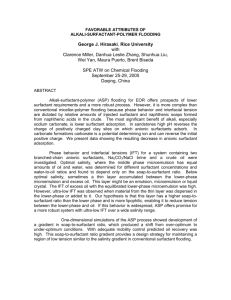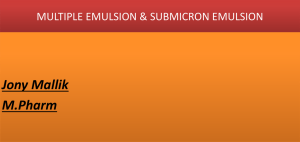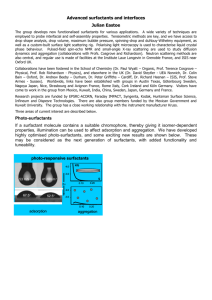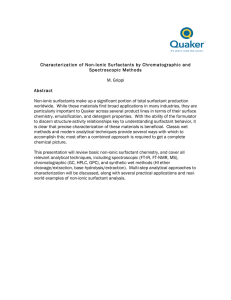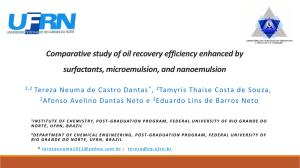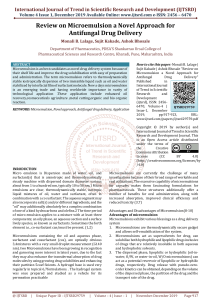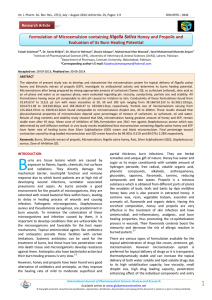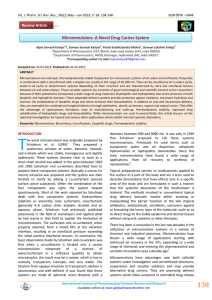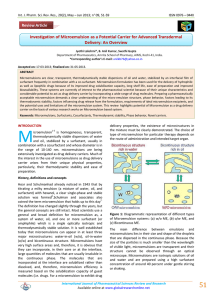Document 13308279
advertisement
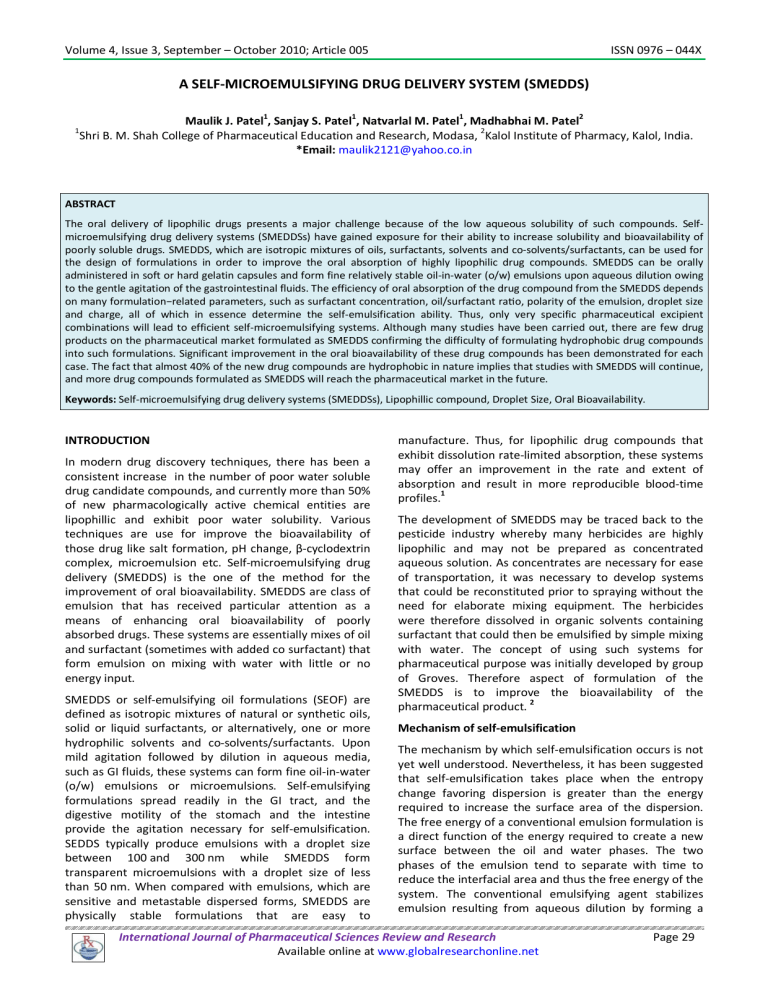
Volume 4, Issue 3, September – October 2010; Article 005 ISSN 0976 – 044X A SELF-MICROEMULSIFYING DRUG DELIVERY SYSTEM (SMEDDS) 1 Maulik J. Patel1, Sanjay S. Patel1, Natvarlal M. Patel1, Madhabhai M. Patel2 2 Shri B. M. Shah College of Pharmaceutical Education and Research, Modasa, Kalol Institute of Pharmacy, Kalol, India. *Email: maulik2121@yahoo.co.in ABSTRACT The oral delivery of lipophilic drugs presents a major challenge because of the low aqueous solubility of such compounds. Selfmicroemulsifying drug delivery systems (SMEDDSs) have gained exposure for their ability to increase solubility and bioavailability of poorly soluble drugs. SMEDDS, which are isotropic mixtures of oils, surfactants, solvents and co-solvents/surfactants, can be used for the design of formulations in order to improve the oral absorption of highly lipophilic drug compounds. SMEDDS can be orally administered in soft or hard gelatin capsules and form fine relatively stable oil-in-water (o/w) emulsions upon aqueous dilution owing to the gentle agitation of the gastrointestinal fluids. The efficiency of oral absorption of the drug compound from the SMEDDS depends on many formulation−related parameters, such as surfactant concentra on, oil/surfactant ra o, polarity of the emulsion, droplet size and charge, all of which in essence determine the self-emulsification ability. Thus, only very specific pharmaceutical excipient combinations will lead to efficient self-microemulsifying systems. Although many studies have been carried out, there are few drug products on the pharmaceutical market formulated as SMEDDS confirming the difficulty of formulating hydrophobic drug compounds into such formulations. Significant improvement in the oral bioavailability of these drug compounds has been demonstrated for each case. The fact that almost 40% of the new drug compounds are hydrophobic in nature implies that studies with SMEDDS will continue, and more drug compounds formulated as SMEDDS will reach the pharmaceutical market in the future. Keywords: Self-microemulsifying drug delivery systems (SMEDDSs), Lipophillic compound, Droplet Size, Oral Bioavailability. INTRODUCTION In modern drug discovery techniques, there has been a consistent increase in the number of poor water soluble drug candidate compounds, and currently more than 50% of new pharmacologically active chemical entities are lipophillic and exhibit poor water solubility. Various techniques are use for improve the bioavailability of those drug like salt formation, pH change, β-cyclodextrin complex, microemulsion etc. Self-microemulsifying drug delivery (SMEDDS) is the one of the method for the improvement of oral bioavailability. SMEDDS are class of emulsion that has received particular attention as a means of enhancing oral bioavailability of poorly absorbed drugs. These systems are essentially mixes of oil and surfactant (sometimes with added co surfactant) that form emulsion on mixing with water with little or no energy input. SMEDDS or self-emulsifying oil formulations (SEOF) are defined as isotropic mixtures of natural or synthetic oils, solid or liquid surfactants, or alternatively, one or more hydrophilic solvents and co-solvents/surfactants. Upon mild agitation followed by dilution in aqueous media, such as GI fluids, these systems can form fine oil-in-water (o/w) emulsions or microemulsions. Self-emulsifying formulations spread readily in the GI tract, and the digestive motility of the stomach and the intestine provide the agitation necessary for self-emulsification. SEDDS typically produce emulsions with a droplet size between 100 and 300 nm while SMEDDS form transparent microemulsions with a droplet size of less than 50 nm. When compared with emulsions, which are sensitive and metastable dispersed forms, SMEDDS are physically stable formulations that are easy to manufacture. Thus, for lipophilic drug compounds that exhibit dissolution rate-limited absorption, these systems may offer an improvement in the rate and extent of absorption and result in more reproducible blood-time profiles.1 The development of SMEDDS may be traced back to the pesticide industry whereby many herbicides are highly lipophilic and may not be prepared as concentrated aqueous solution. As concentrates are necessary for ease of transportation, it was necessary to develop systems that could be reconstituted prior to spraying without the need for elaborate mixing equipment. The herbicides were therefore dissolved in organic solvents containing surfactant that could then be emulsified by simple mixing with water. The concept of using such systems for pharmaceutical purpose was initially developed by group of Groves. Therefore aspect of formulation of the SMEDDS is to improve the bioavailability of the pharmaceutical product. 2 Mechanism of self-emulsification The mechanism by which self-emulsification occurs is not yet well understood. Nevertheless, it has been suggested that self-emulsification takes place when the entropy change favoring dispersion is greater than the energy required to increase the surface area of the dispersion. The free energy of a conventional emulsion formulation is a direct function of the energy required to create a new surface between the oil and water phases. The two phases of the emulsion tend to separate with time to reduce the interfacial area and thus the free energy of the system. The conventional emulsifying agent stabilizes emulsion resulting from aqueous dilution by forming a International Journal of Pharmaceutical Sciences Review and Research Available online at www.globalresearchonline.net Page 29 Volume 4, Issue 3, September – October 2010; Article 005 ISSN 0976 – 044X monolayer around the emulsion droplets, reducing the interfacial energy and forming a barrier to coalescence. On the other hand, emulsification occurs spontaneously with SEDDS because the free energy required to form the emulsion is either low and positive or negative. It is necessary for the interfacial structure to show no resistance against surface shearing in order for emulsification to take place. The ease of emulsification was suggested to be related to the ease of water penetration into the various LC or gel phases formed on the surface of the droplets. The interface between the oil and aqueous continuous phases is formed upon addition of a binary mixture. This is followed by the solubilization of water within the oil phases as a result of aqueous penetration through the interface. This will occur until the solubilization limit is reached close to the interphase. Further aqueous penetration will loaded to the formation of the dispersed LC phase. In the end, everything that is in close proximity with the interface will be LC, the actual amount of which depends on the surfactant concentration in the binary mixture. Thus, following gentle agitation of the self-emulsifying system, water will rapidly penetrate into the aqueous cores and lead to interface disruptions and droplet formation. As a consequence of the LC interface formation surrounding the oil droplets, SEDDS become very stable coalescence. Detailed studies have been carried out to determine the involvement of LC phase in the emulsion formation process. Also, particle size analysis and low frequency dielectric spectroscopy (LFDS) were utilized to examine the self-emulsifying properties of a series of lmwitor 742 (a mixture of mono- and diglycerides of capric acids)/ Tween 80 system. The results suggested that there might be a complex relationship between LC formation and emulsion formation. Moreover, the presence of the drug compound may alter the emulsion characteristics, probably by interacting with the LC phase. Nevertheless, the correlation between the LC formation and spontaneous emulsification has still not been 1 established. physical stability and ability to be delivered in standard soft gelatin capsules. Improvement of oral absorption by SMEDDS The release of the drug compound from SMEDDS takes place upon its partitioning into the intestinal fluids during droplet transport and disintegration along the GI tract. It was proposed that two main factors, small particle size and polarity of the resulting oil droplets determine the efficient release of the drug compound from SMEDDS. In o/w microemulsions, however, the impact of the polarity of the oil droplets is not very significant because the drug compound reaches the capillaries incorporated within the oil droplets. Many studies carried out in animals for the assessment of the oral bioavailability of hydrophobic drugs formulated in o/w emulsions indicated better absorption profiles but, the use of these systems is limited due to their poor physical stability and the large volumes needed. Thus, SMEDDS may be a promising alternative to orally administered emulsions because of their relatively high A higher bioavailability of hydrophobic drugs incorporated in SMEDDS was reported earlier. A study carried out in non-fasting dogs for the assessment of the oral bioavailability of a lipophilic naphthalene derivative formulated in SMEDDS demonstrated three−fold higher values in Cmax and AUC as compared to other dosage forms. In another study done on rats, the oral bioavailability of the anti-inflammatory drug ontazolast was substantially improved when this lipophilic drug was administered in a lipid based formulation, such as emulsion, glyceryl oleate (Peceol) solution, and SMEDDS in comparison to the suspension formulation. A multiple dosage study was conducted on humans diagnosed with HIV infection who were given orally an HIV protease inhibitor either as a SMEDDS or as an elixir. Greater AUC values in addition to higher Cmax and Cmin values were reported for patients given the SMEDDS as compared to the ones given the elixir.1 Physicochemical properties for the selection of drug Poorly water soluble drugs are a broad class of drugs that differ significantly in physicochemical properties, so it would be useful if there were practical guidelines to help identify the most appropriate formulation for specific drugs. High melting point drugs with log P values of about 2 are poorly suited to SEMDDS. At the other end of the spectrum, lipophilic drugs, such as cinnarizine with log P values greater than 5, are good candidate for SMEDDS. Drug incorporation into SMEDDS Drugs with low aqueous solubility present a major challenge during formulation as their high hydrophobicity prevents them from being dissolved in most approved solvents. The novel synthetic hydrophilic oils and surfactants usually dissolve hydrophobic drugs to a greater extent than conventional vegetable oils. The addition of solvents including ethanol, PG and PEG, may also contribute to the improvement of drug solubility in the lipid vehicle. The efficiency of drug incorporation into a SMEDDS is generally specific to each case depending on the physicochemical compatibility of the drug/system. In most cases, there is an interference of the drug with the selfemulsification process up to a certain extent leading to a change in the optimal oil/surfactant ratio. The efficiency of a SMEDDS can be altered either by halting charge movement through the system by direct complexation of the drug compound with some of the components in the mixture through its interaction with the LC phase, or by penetration into the surfactant interfacial monolayer. The interference of the drug compound with the self-emulsification processs may result in a change in droplet size distribution that can vary as a function of drug concentration. It should be pointed out that emulsions with smaller oil droplets in more complex formulations are more prone to changes caused by addition of the drug compound. Hence, the design of an International Journal of Pharmaceutical Sciences Review and Research Available online at www.globalresearchonline.net Page 30 Volume 4, Issue 3, September – October 2010; Article 005 ISSN 0976 – 044X optimal SEDDS requires pre-formulation solubility and phase diagram studies to be conducted.1 illustrating these features is presented in figure 1.8 It should be noted that not every combination of components produce microemulsions over the whole range of possible compositions, in some instances the extent of microemulsion formation may be very limited. Construction of phase-diagram The relationship between the phase behavior of a mixture and its composition can be captured with the aid of a phase diagram. Compositional variables can also be studied as a function of temperature and, pressure, although with the exception of microemulsions prepared using supercritical or near critical solvents, or with liquefied chlorofluorocarbon and HFA propellants, the large majority of systems are studied under conditions of ambient pressure. The phase behavior of simple microemulsion systems comprising oil, water and surfactant can be studied with the aid of ternary phase diagram in which each corner of the diagram represents 100% of that particular component. More commonly however, and almost always in the case of microemulsions in pharmaceutical applications, the microemulsion will contain additional components such as a co surfactant and/or drug. Figure 1: Example of Phase Diagram The Co-surfactant is also amphiphilic with an affinity for both the oil and aqueous phases and partitions to an appreciable extent into the surfactant interfacial monolayer present at the oil-water interface. The Co-surfactant need not necessarily be capable of forming association structures in its own right. A wide variety of molecules can functions also surfactants including non-ionic surfactants, alcohols, alkanoic acids, alkanediols and alkyl amines. Surprisingly few studies have examined the effect of drug on phase behavior, this is despite the fact that large numbers of drug molecules are themselves surface active and as such would be expected to influence phase behavior.3 (Kawakami, 2002) In the case where four or more components are investigated, pseudo-ternary phase diagrams are used where a corner will typically represent a binary mixture of two components such as surfactant / Co-surfactant, water /drug or oil / drug. The number of different phases present for a particular mixture can be visually assessed. A highly schematic (pseudo) ternary phase diagram Constructing phase diagrams is time consuming, particularly when the aim is to accurately delineate a phase boundary, as the time taken for the system to equilibrate can be greatly increased as the phase boundary is approached. Heat and sonication are often used, particularly with systems containing nonionic surfactants, to speed up the process. Care must be taken to ensure not only that the temperature is precisely and accurately controlled, but also that observations are not made on metastable system. Clearly, however, time constraints impose a physical limit on the length of time system can be left to equilibrate and consequently the elimination of metastable states can be difficult to ensure in practice, although centrifugation can be useful to speed up any separation. Within this region, and indeed other multi phase regions of the ternary phase diagram, microemulsions can exist in equilibrium with excess water or oil phases. These multiphase systems can be conveniently described using the Winsor classification.3 In the Winsor classification, the one phase microemulsions that are generally explored as drug delivery systems are known as Winsor IV systems. Microemulsions stabilized by non-ionic surfactants, especially those based on polyoxyethylene, are very susceptible to temperature because a decrease in surfactant solubility occurs with increasing temperature, and as a result systems stabilized by non-ionic surfactants or mixtures thereof often have characteristic phase inversion temperatures (PITs), with the PIT of the microemulsion varying with a range of experimental factors including the amount and nature of the oil present and the nature of the surfactant(s) present. Ternary phase diagrams were constructed using Capmul PG8 (propylene glycol monocaprylate) as the oil, Tween 20 (polysorbate 20) and/or Cremophor EL (polyoxyl 35 castor oil) as surfactants. Formulation of SMEDDS SMEDDS formulation containing following components 1) Oil phase 2) Primary surfactant 3) Secondary surfactant (co-surfactant) 4) Co-Solvent These isotropic systems are usually easier to formulate than ordinary emulsion. The type of associated structure formed from these components at particular temperature depends not only on the chemical nature of each component but also on their relative concentration. International Journal of Pharmaceutical Sciences Review and Research Available online at www.globalresearchonline.net Page 31 Volume 4, Issue 3, September – October 2010; Article 005 1) Oil phase In order to make SMEDDS systems pharmaceutically acceptable, it is necessary to prepare such systems by 4 using nontoxic and safe components. Oil from natural sources and their derivatives, e.g. triglycerides and fatty acid methyl esters are easily degraded by microorganism and considered to be harmless to the environment. The formation of bicontinuous microemulsions with mineral oils has been intensively investigated in model 5 experiments and for application in industrial products. An acceptable lipophilic phase for pharmaceutical uses would be vegetable oils. The extension of a microemulsion region generally depends on nature of oil. This is due to differences in oil penetration into the surfactant layer. 6 ISSN 0976 – 044X the relative contribution of hydrophilic and hydrophobic fragments of the surfactant molecule. It accepted that low HLB (3-6) surfactants are favored for the formation of w/o microemulsions whereas surfactants with high HLB (818) are preferred for the formation of o/w microemulsion systems. Ionic surfactants such as sodium dodecyl sulphate which have HLBs greater than 20, often require the presence of a co surfactant to reduce their effective HLB to a value within the range required for microemulsion formation. In contrast, the CPP relates the ability of surfactants to form particular aggregates to the geometry of the molecule itself. The analysis of film curvature for surfactant association leading to microemulsion formation has been explained by Isaraelachvili 3 In terms of the packing ratio, P Example: Castor oil, Sunflower oil, Olive oil, Hydrogenated specialty oils Seseam oil, 2) Surfactant A surfactant molecule is formed by two parts with different affinities for the solvents. One of them has affinity for water (polar solvents) and the other has for oil (non-polar solvents). A little quantity of surfactant molecules rests upon the water-air interface and decreases the water surface tension value (the force per unit area needed to make available surface). That is why the surfactant name: “surface active agent”. 7 Figure 2: Shows structure of surfactant molecule containing hydrophilic head and hydrophobic tail group. Surfactants used to stabilize microemulsion system may be: (i) non-ionic, (ii) zwitterionic, (iii) cationic, or (iv) anionic surfactants. Combinations of these, particularly ionic and non-ionic, can be very effective at increasing the extent of the microemulsion region. Examples of nonionic include polyoxyethylene surfactants such as Brij 35 or sugar esters such as sorbitan monooleat (Span 80). The use of additional surfactants such as sodium dodecyl sulfate or sodium deoxycholate significantly improved the solubilization capacity of the oils, although formulations free of these surfactants ware also available. These microemulsion formulations can be administered as a form of water-in-oil microemulsion or surfactant-oil mixture, and are expected to convert to oil-in-water microemulsion in small intestine. 8 Attempts have been made to rationalize surfactant behavior in terms of the hydrophile-lipophile balance (HLB), as well as the critical packing parameter (CPP). Both approaches are fairly empirical but can be a useful guide to surfactant selection. The HLB takes into account Figure 3: CPP of surfactant molecule P = Vo/AoLo Where VO = partial molar volume of the surfactant Ao= cross sectional area of the surfactant head group Lo = maximum length of the surfactant chain The packing ratio provides a direct measure of HLB and is influenced by the same factors. The o/w structure are favored if the effective polar part is more bulky then the hydrophobic part (P<1), and the interface curves spontaneously toward water (positive curvature). The w/o structures are formed, when the interface curves in the opposite direction (p>1, negative curvature). At zero curvature, when the HLB balanced (P~1), either bicontinuous or lamellar structures may form according to the rigidity of the film.4 Example: Propylene glycol monocaprylate (Capryol 90) Polyglycolized glycerides (Gelucire 44/14, 50/13) Polyoxyl-40 hydrogenated castor oil (Cremophor RH 40) Oleoyl macrogol-8 glycerides (Labrafil M 1944 CS) Linoleoyl macrogolglycerides (Labrafil M 2125 CS) PEG-8 caprylic/capric glycerides (Labrasol) Polyoxyethylene glyceryl trioleate (Tagat TO) Polyoxyethylene(20)sorbitan monooleate (Tween 80) International Journal of Pharmaceutical Sciences Review and Research Available online at www.globalresearchonline.net Page 32 Volume 4, Issue 3, September – October 2010; Article 005 3) Co-surfactant Most single-chain surfactants do not lower the oil-water interfacial tension sufficiently to form microemulsions nor are they of the correct molecular structure. Further under certain condition, a combination of oil, water and surfactant will result in a phase where there are orderly planes of oil and water separated by monomolecular layer of surfactant. This type of phase is known as liquid crystal (lamellar phase). Liquid crystals formation can be detected by large increase in viscosity. Co-surfactant is added to further lower the interfacial tension between the oil and water phase, fluidize the hydrocarbon region of the 9 interfacial-film, and to influence the film curvature. Typical co-surfactants are short chain alcohols (ethanol to butanol), glycols such as propylene glycol, medium chain alcohols, amines or acids. Abe et al (1986) concludes that the role of co-surfactant is to destroy liquid crystalline or gel structures that form in place of a microemulsion phase. They also conclude that cosurfactant free microemulsion in most system cannot be made except at high temperature. El-Nokaly et al summarized the role of a Co-surfactant as following: -10 1) Increase the fluidity of the interface 2) Destroy liquid crystalline or gel structure which would prevent the formation of microemulsion. 3) Adjust HLB value and spontaneous curvature of the interface by changing surfactant partitioning characteristic 4) Co-solvents The production of an optimum SEDDS requires relatively high concentrations (generally more than 30% w/w) of surfactants. Organic solvents such as, ethanol, propylene glycol (PG), and polyethylene glycol (PEG) are suitable for oral delivery, and they enable the dissolution of large quantities of either the hydrophilic surfactant or the drug in the lipid base. These solvents can even act as co-surfactants in microemulsion systems. On the other hand, alcohols and other volatile co-solvents have the disadvantage of evaporating into the shells of the soft gelatin, or hard, sealed gelatin capsules in conventional SEDDS leading to drug precipitation. Thus, alcohol−free formula ons have been designed, but their lipophilic drug dissolution ability 1 may be limited. Characterization of SMEDDS: Differential scanning calorimetry Differential scanning calorimetry for SMEDDS can be determined using DSC 60. Liquid sample and Solid sample should be placed in the aluminum pan and result can be recorded. Any type of chemical interaction should be determined using DSC.11 Fourier transform-infrared spectroscopy Fourier transform-infrared for SMEDDS can be determined using FT-IR. Liquid sample should be placed in the liquid sample holder and result can be recorded. ISSN 0976 – 044X Any type of chemical interaction should be determined using FT-IR. 12 Macroscopic evaluation Macroscopic analysis was carried out in order to observe the homogeneity of microemulsion formulations. Any change in color and transparency or phase separation occurred during normal storage condition (37±2ºC) was observed in optimized microemulsion formulation. Visual assessment To assess the self-emulsification properties, formulation (60 mg) was introduced into 100 ml of water in a glass Erlenmeyer flask at 25°C and the contents were gently stirred manually. The tendency to spontaneously form a transparent emulsion was judged as good and it was judged bad when there was poor or no emulsion formation. Phase diagram was constructed identifying the good self-emulsifying region.13 Determination of Self emulsification time The emulsification time of SMEDDS was determined according to USP 22, dissolution apparatus 2. 300 mg of each formulation added drop wise to 500ml purified water at 37ºC. Gentle agitation was provided by a standard stainless steel dissolution paddle rotating at 50 rpm. Emulsification time was assessed visually.14 Solubility studies Unknown amount of selected vehicles was added to each cap vial containing an excess of drug. After sealing, the mixture was heated at 40ºC in a water bath to facilitate the solubilization. Mixing of the systems was performed using a vortex mixer. Formed suspensions were then shaken with a shaker at 25ºC for 48 hours. After reaching equilibrium, each vial was centrifuged at 3000 rpm for 5 minutes, and excess insoluble LOV was discarded by filtration using a membrane filter (0.45 µm, 13 mm, Whatman, India). The concentration of drug was then quantified by U.V.Spectrophotometer.13 Transmittance Test Stability of optimized microemulsion formulation with respect to dilution was checked by measuring Transmittance through U.V. Spectrophotometer (UV-1700 SHIMADZU). Transmittance of samples was measured at 650nm and for each sample three replicate assays were performed.13 Droplet size determination It is a precise method for evaluation of stability. Size of droplet is measured by photon-correlation spectroscopy (PSC) with Zetasizer. All measurements are carried out at scattering angle of 90° and 25°C temperatures. Prior to measurement, microemulsion is diluted in two-steps with pure water then it is filtered through a 0.22um filter just before it is added to cuvette. In first step it is diluted with equal amount of water. In second step the mixture is further diluted to International Journal of Pharmaceutical Sciences Review and Research Available online at www.globalresearchonline.net Page 33 Volume 4, Issue 3, September – October 2010; Article 005 appropriate concentration for the measurement. That depends on droplet size (Usually diluted 100-200 times). 15 Zeta potential measurement Zeta potential for microemulsion was determined using Zetasizer HSA 3000 (Malvern Instrument Ltd., UK). Samples were placed in clear disposable zeta cells and results were recorded. Before putting the fresh sample, cuvettes were washed with the methanol and rinsed using the sample to be measured before each experiment.14 Stability16 Temperature Stability Shelf life as a function of time and storage temperature was evaluated by visual inspection of the SMEDDS system at different time period. SMEDDS was diluted with purified distilled water and to check the temperature stability of samples, they were kept at three different temperature range (2-8°C (refrigerator), Room temperature) and observed for any evidences of phase separation, flocculation or precipitation. Centrifugation In order to estimate metastable systems, the optimized SMEDDS formulation was diluted with purified distilled water. Then microemulsion was centrifuged (Remi Laboratories, Mumbai, India) at 1000 rpm for 15 minute at 0°C and observed for any change in homogeneity of microemulsions. ISSN 0976 – 044X Sustain release from SMEDDS Due to the wide range of structures occurring in them, SMEDDS display a rich behavior regarding the release of solubilized material. Thus in. case of O/W microemulsion, hydrophobic drugs solubilized mainly in the oil droplets, experience hindered diffusion and are therefore released rather slowly (depending on the oil/water partitioning of the substance). Water soluble drugs, on the other hand, diffuse essentially without obstruction (depending on the volume fraction of the dispersed phase) and are release fast. For balanced microemulsions, relatively fast diffusion and release occur for both water soluble and oil soluble drugs due to the bicontinuous nature of microemulsion "structure".4 Apart from the microemulsion structure, the microemulsion composition is important for the drug release rate. Increase the bioavailability of drug Many of drugs were lipophilic in nature so, it should be insoluble in water. Lipophilic drug should have low bioavailability. In SMEDDS, drugs should be combining with the oil and make a complex. Oil is easily absorbed from the gut and increase the solubility of drugs. So increase the bioavailability of the drug. Ex. Julianto et al, was increase the 3 fold bioavailability from SEDDS which is composed of the Tween 80 and palm oil. 18 REFERENCES 1. Neslihan Gursoy, R. and Benita, S. Self-emulsifying drug delivery systems (SEDDS) for improved oral delivery of lipophilic drugs. Biomedicine & Pharmacotherapy; 2004; 58; 173–182. 2. Attwood, A. Colloidal drug delivery systems, In: Kreutzer, J. (Ecls.) Microemulsions. Marcel Dekker; New York; 1994; 33-71. 3. Lawrence, M. J. and Rees, G. D. Microemulsion-based media as novel drug delivery systems. Adv. Drug Delivery Rev.; 2000; 45; 89-121. 4. Kumar, P. and Mital, K. L. Handbook of microemulsion: Science and Technology. Marcel Dekker, New York, Basel; 1999. 5. Lin, S.L.; Menig, J. and Lachman, L. Interdependence of physiological surfactant and drug particle size on the dissolution behavior of water-insoluble drugs. J. Pharm. Sci.; 1968; 2143-2148. 6. Shford, D. M. and Craig D. Q. M. The emulsification and solubilization properties of polyglycolysed oils in self-emulsifying formulations. J. Pharm. Pharmacol.; 2004; 56; 307-316. 7. Alander, S.; Gennes, P. O. and Taupin C. Microemulsions and the flexibility of oil /water interfaces. J. Phys. Chem.. 1982; 86; 2294- 2304. 8. Kawakami, K. and Yoshikawa, T. Microemulsion formulation for enhanced absorption of poorly soluble drug I Prescription design. Journal of Controlled In vitro release The quantitative in vitro release test was performed in 900 ml purified distilled water, which was based on USP 24 method. SMEDDS was placed in dialysis bag during the release period to compare the release profile with conventional tablet. 10 ml of sample solution was withdrawn at predetermined time intervals, filtered through a 0.45 µ membrane filter, dilute suitably and analyzed spectrophotometrically. Equal amount of fresh dissolution medium was replaced immediately after withdrawal of the test sample. Percent drug dissolved at different time intervals was calculated using the Beer 17 Lambert’s equation. Applications of SMEDDS Solubilization in SMEDDS Owing to their frequently high content oil, as well as of surfactant, SMEDDS are usually efficient solubilizers of substances of a wide range of lipophilicity. Thus, the solubilizing capacity of a w/o microemulsion for water soluble drugs is typically higher than that of an o/w microemulsion, while the reverse is true for oil soluble drugs. Furthermore, the solubilization depends on the SMEDDS composition. International Journal of Pharmaceutical Sciences Review and Research Available online at www.globalresearchonline.net Page 34 Volume 4, Issue 3, September – October 2010; Article 005 ISSN 0976 – 044X Release; 2002; 81; 65-74. 9. Ozawa, K.; Olsson, U. and Cawes, A. Oil-induced structural change in nonionic microemulsions. Journal of Dispersion Science and Technology; 1986; 22(1); 119124. 10. El-Nokaly, I. and Ravey, J. Solubilization by nonionic surfactant in the HLB Temperature Range. In: Micellization, solubilization and Microemulsions, Vol.2 (R.K.Mittal, ed.), Plennum press, New York; 1991; 901911. (SMEDDS) containing Atorvastatin. Pharmacy and pharmacology; 2006; 1183-1191. 14. Wei, L.; Li, J.; Guo, L.; Nei, S. and Pan, W. Preparation and evaluation of SEDDS and SMEDDS containing Carvedilol. Drug development and industrial pharmacy; 2005; 31; 785-794. 15. Zhang, P.; Liu, Y.; Feng, N. and Xu, J. Preparation and evaluation of self-microemulsifying drug delivery system of oridonin. International journal of pharmacy; 2007. 11. Taha, E.; Saidan, S.; Samy. A. and Khana, M. Preparation and in vitro characterization of selfnanoemulsified drug delivery system (SNEDDS) of alltrans-retinol acetate. International journal of pharmaceutics; 2004; 285; 109–119. 16. 12. Nazzal, S.; Smalyukh, I. I.; Lavrentovich, O. D. and Khan M. A. Preparation and in vitro characterization of a eutectic based semisolid self-nanoemulsified drug delivery system (SNEDDS) of ubiquinone: mechanism and progress of emulsion formation. International Journal of Pharmaceutics;2002; 235; 247–265. 17. Kang, B.; Lee, J.; Chon, S.; Jeong, S.; Yuk, S.; Khang, G.; Lee, H. and Hang Choc S. Development of selfmicroemulsifying drug delivery systems (SMEDDS) for oral bioavailability enhancement of simvastatin in beagle dogs. International journal of pharmaceutics; 2004; 274; 65-73. 13. Shen, H. and Zhong, M. Preparation and evaluation of self-microemulsifying drug delivery systems Ghosh, P. K.; Umrethia, M. L.; Majethiya, R. J.; and Murthy, R. S. R. Preparation and Physicochemical characterisation of caprylocapryl macrogol -8glycerides microemulsion for oral drug delivery. Ars Pharm; 2004; 45 (3); 353-372. 18. Julianto, T.; Yuen, K. and Noor, A. Improved bioavailability of vitamin E with a self-emulsifying formulation. International journal of pharmaceutics; 2000; 200; 53–57. *********** International Journal of Pharmaceutical Sciences Review and Research Available online at www.globalresearchonline.net Page 35
